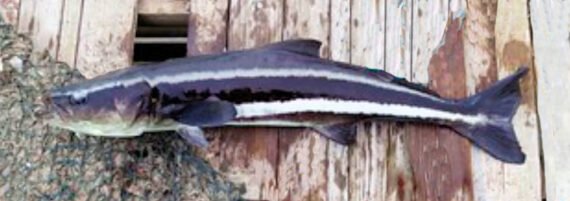Cobia, Rachycentron canadum
 Cobia, Rachycentron canadum. Fish caught from coastal waters off Sebastian, Florida, November 2021. Length: 1.04 m (3 feet 5 inches). Catch, photograph, and identification courtesy of Ben Cantrell, Sebastian, Florida.
Cobia, Rachycentron canadum. Fish caught from coastal waters off Sebastian, Florida, November 2021. Length: 1.04 m (3 feet 5 inches). Catch, photograph, and identification courtesy of Ben Cantrell, Sebastian, Florida.
 Cobia, Rachycentron canadum. Fish caught from coastal waters off Brownsville, Texas, March 2021. Length: 1.50 m (4 feet 11 inches). Catch, photograph and identification courtesy of Eli (obsessiveangling.wordpress.com).
Cobia, Rachycentron canadum. Fish caught from coastal waters off Brownsville, Texas, March 2021. Length: 1.50 m (4 feet 11 inches). Catch, photograph and identification courtesy of Eli (obsessiveangling.wordpress.com).
The Cobia, Rachycentron canadum, is a member of the Cobia or Rachycentridae Family that is known in Mexico also as cobia. The Cobia is the sole member of the genus Rachycentron and the sole member of the Rachycentridae Family being found in Mexican waters of the Atlantic Ocean.
The Cobia has an elongated fusiform cylindrical body. They are black dorsally transitioning to dark brown on the sides and yellowish to white ventrally. They have two sharply defined brown bands on the sides with the first extending from the eyes to the caudal peduncle and the other from the pectoral fin base to the center of the caudal peduncle that are bordered above and below by paler bands and are more prominent and darker when spawning. Their fins are deep brown with the exception that the anal and pelvic fins have gray markings. Their caudal fin is dark brown. The juveniles have conspicuous bands of black and white on their sides. Their head is broad and depressed with a long, pointed face, small eyes with a large mouth that opens at the front and has a projecting lower jaw that has numerous fibrous villiform teeth on the jaws, tongue and roof. Their anal fin is long with 1 to 3 spines and 26 to 33 rays and originates under the apex of the second dorsal fin; their caudal fin is lunate to emarginate in adults with the upper lobe being longer than the lower and rounded in juveniles with prolonged central rays; their first dorsal fin has 7 to 9 short isolated spines; the second dorsal fin is long and has and 26 to 33 rays being elevated at the front; their pectoral fins are , curved, large, pointed, and triangular; and, their pelvic fins are short and inserted before the pectoral fin base. They are covered with small smooth scales. Their lateral line is wavy at the front.
The Cobia is an offshore pelagic schooling species that is found within and around reefs and in coastal and brackish waters over gravel, mud and sand substrate as solitary individuals within and around reefs to depths up to 1,200 m (3,900 feet) in temperate and tropical waters. They also frequent structures such as buoys, oil platforms and flotsam. Juveniles are often found in pelagic Sargassum weedlines. They are eurythermal capable of surviving waters between 2oC (36oF) and 32oC (90oF) and euryhaline found in salinities from 5.0 to 44.5 ppt. They are known to associate with structure. They are fast growing for the first four years and reach a maximum of 2.0 m cm (6 feet 6 inches) in length and 68 kg (150 lbs) in weight. As of January 1, 2024, the International Game Fish Association world record stood at 61.5 kg (135 lbs 9 oz) with the fish caught from coastal waters off Australia, July 1985. They hunt in packs and consume crabs, small fish, and shrimp; they are known to follow manta rays, sharks and turtles and scavenger their left-over food. In turn they are preyed upon larger predatory fishes that include Dorado, Coryphaena hippurus, and Shortfin Mako, Isurus oxyrinchus. The Cobia migrate to the northern Gulf of Mexico for the winter months and move as far north as Massachusetts for the summer. Reproduction is not well-documented but involves the forming of large aggregations in the Gulf of Mexico during the warmer months with pelagic spawning and the release of hundreds of thousands of pelagic eggs by each female; the larvae are also pelagic. The females are capable of spawning up to 30 times per season. They have lifespans of up to fifteen years.
The Cobia is a resident of all Mexican waters of the Atlantic Ocean.
The Cobia is a straightforward identification and cannot be easily confused with any other species due to their unique first dorsal fin, however, they are close relatives, found in close proximity and resemble the Remoras of the Echeneidae Family but lack the dorsal sucker and have stouter bodies.
From a conservation perspective the Cobia is currently considered to be of Least Concern with stable, widely distributed populations. They are heavily pursued by recreational anglers in the Gulf of Mexico and considered to be an excellent food fish. In US waters they are heavily regulated. They are not pursued commercially due to their limited availability. They are caught as a bi-catch by shrimp trawlers and by longliners. They are currently heavily pursued via aquaculture due to their rapid growth rates and high quality food value. These aquaculture efforts are primarily in Southeast Asia but are also on going in the coastal waters off Campeche.